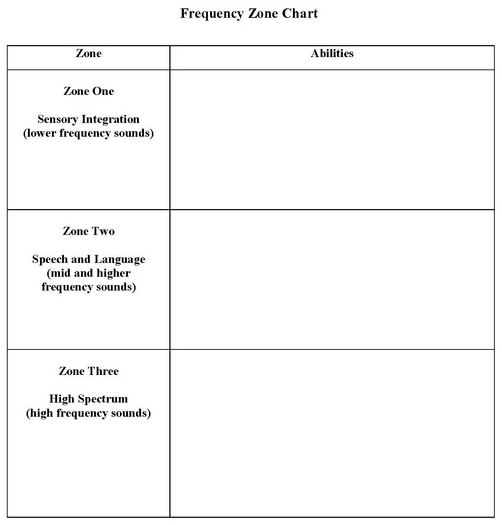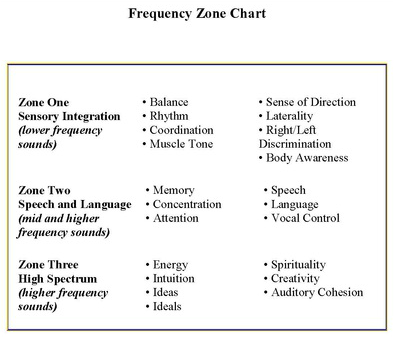TOMATIS
Answer
the following questions using the attached handout. All of the information you need for each
questions is in the handout. You can put
the answers in your own words, or you can copy the information directly from
the handout. The purpose is for you to
get familiar with the theories of Dr. Tomatis which provide the foundation for
much of the audio listening we are doing in class.
1. Who was Alfred Tomatis and what discoveries did he make about the ear?
2. Tomatis came to believe that the ear was much more than an organ of hearing. List three functions he believed the ear was responsible for.
3. In the 1950s Tomatis developed a listening technique to 're-educate the ear' based upon the following four principles:
4. Among other discoveries, Dr. Tomatis helped identify the relationship between certain sound frequencies and their effect on functions of the mind and body. A simplified explanation of Dr. Tomatis’ findings shows that certain bands, or zones, of sound frequencies affect different abilities. The chart below lists the three zones Tomatis identified. Fill in the Abilities Column to learn what different abilities relate to each sound frequency zone.
1. Who was Alfred Tomatis and what discoveries did he make about the ear?
2. Tomatis came to believe that the ear was much more than an organ of hearing. List three functions he believed the ear was responsible for.
3. In the 1950s Tomatis developed a listening technique to 're-educate the ear' based upon the following four principles:
4. Among other discoveries, Dr. Tomatis helped identify the relationship between certain sound frequencies and their effect on functions of the mind and body. A simplified explanation of Dr. Tomatis’ findings shows that certain bands, or zones, of sound frequencies affect different abilities. The chart below lists the three zones Tomatis identified. Fill in the Abilities Column to learn what different abilities relate to each sound frequency zone.

During
the last half of the twentieth century, Alfred A. Tomatis, a French M.D., researcher
and ear, nose and throat specialist, defined the ear as a primary organ for
multiple physical, emotional and neurological development responses. Not only
is the ear and its complex ability to send information to the brain and the
body primary for hearing and sound perception, it establishes balance and
equilibrium. It is also primary for the development of verticality, spatiality,
laterality and language development.
Tomatis, made his pioneering discovery that “the voice can only produce the harmonics that the ear is able to perceive.” This identification of the role that the ear played in vocal production became the first law of what later came to be called the “Tomatis Effect.” Tomatis also discovered that if the missing frequencies could be restored to the ear, through a device he called the Electronic Ear (EE) they would be returned to the voice and with sufficient training of the ear and voice through the EE, the changes would become permanent. These discoveries had important implications for populations as diverse as singers and children having difficulty in acquiring language.
Tomatis came to believe that the ear was much more than an organ of hearing. It is, he maintained in charge of functions including; energizing and regulating the brains state of alertness and attention; coordinating posture and movement; and connecting our intentions and thoughts with our physical and verbal transactions upon our environment. Tomatis’ life mission eventually became the understanding of how the ear was physiologically involved in acquiring and controlling of the voice and language. To this end he invented several technologies, which could be used to rehabilitate the ear related functions of alertness, attention, coordination and voice.
Tomatis's innovative research is based on the ear's ability to discriminate between sounds it selects to hear and the ability to tune out sounds that are unwanted. The ear's ability to listen and focus, select sounds spatially and regulate auditory information as it is perceived by the brain, has become the theme in over a hundred centers worldwide dedicated to assist children and adults with speech and communication disorders, attention deficit disorders, head injuries, and autism.
The listening process beings in utero when the fetus becomes aware of sound and frequencies in the liquid world of the heartbeat, breath and sound of the mother's voice. In La Nuit Uterine (Edition Stock, Paris, 1980), Tomatis explores in depth clinical observations on the state of intrauterine listening. He defines the phylogenic and ontogenetic progression of the ear and its neurological implications for the development of language.
Dr. Tomatis proved that the voice can reflect the state of the ear's ability to hear, a phenomenon know as the Tomatis Effect. When the perception of midrange and high frequencies is missing in the prenatal and the first three years of life, difficulties in listening and learning often arise. Without any obvious traces in deafness, a deficient ability to hear frequencies below 1000Hz can cause difficulty in understanding and remembering spoken information. A listening test for each ear was developed by Dr. Tomatis to show specific areas where frequency deficiencies occur. Defective variations in frequencies between 1000Hz and 2000Hz make it difficult to sing in tune. When there are difficulties above 2000Hz, the voice will be dull and not expressive.
Generally, a healthy adult can hear up to the 20,000Hz range, giving a bright and clear ability to distinguish sounds. When there is a loss in the high frequencies, it is necessary to strain. The ability to focus upon and select sounds or voices in a noisy room is one of the primary challenges of those with listening disabilities.
In the 1950's Tomatis developed a listening technique to 're-educate the ear' based upon the following four principles:
The following chart created by Timothy Gilmore from the "Overview of the Tomatis Method" by Gilmore, Madaule, and Thompson, 1989) shows the essential role of the ear.
Receptive Language
At the level of receptive oral language, the following can be considered symptomatic of a listening problem:
Body Image
At the level of body awareness or body image, the following can be observed:
Poor balance or coordination
Difficulty coordinating body movement
Clumsiness or awkwardness in body movement
Excessive body movement when speaking or listening (fidgety)
Poor posture: overly tense and rigid (hyper tonic) or insufficient tonicity (hypo tonic)
Mixed lateral dominance, letter and word reversals, signs of fine motor or gross motor coordination such as poor handwriting
Poor organization and planning skills
The tendency to withdraw or avoid communication in learning situations and/or social situations
A lack of curiosity or interest in learning
Lack of interest in oral communication and, in extreme instances, avoidance or active refusal to use language as the medium through which to communicate with others
Expressive Language
At the level of spoken Language, individuals with listening-based communication problems are frequently seen to have very poor audio-vocal control or self-listening. Such symptoms include:
Developmental Characteristics
In compiling clinical histories at listening centers using the Tomatis method, the following events have had an unusually high incidence among individuals with listening-based learning and communication problems:
Tomatis, made his pioneering discovery that “the voice can only produce the harmonics that the ear is able to perceive.” This identification of the role that the ear played in vocal production became the first law of what later came to be called the “Tomatis Effect.” Tomatis also discovered that if the missing frequencies could be restored to the ear, through a device he called the Electronic Ear (EE) they would be returned to the voice and with sufficient training of the ear and voice through the EE, the changes would become permanent. These discoveries had important implications for populations as diverse as singers and children having difficulty in acquiring language.
Tomatis came to believe that the ear was much more than an organ of hearing. It is, he maintained in charge of functions including; energizing and regulating the brains state of alertness and attention; coordinating posture and movement; and connecting our intentions and thoughts with our physical and verbal transactions upon our environment. Tomatis’ life mission eventually became the understanding of how the ear was physiologically involved in acquiring and controlling of the voice and language. To this end he invented several technologies, which could be used to rehabilitate the ear related functions of alertness, attention, coordination and voice.
Tomatis's innovative research is based on the ear's ability to discriminate between sounds it selects to hear and the ability to tune out sounds that are unwanted. The ear's ability to listen and focus, select sounds spatially and regulate auditory information as it is perceived by the brain, has become the theme in over a hundred centers worldwide dedicated to assist children and adults with speech and communication disorders, attention deficit disorders, head injuries, and autism.
The listening process beings in utero when the fetus becomes aware of sound and frequencies in the liquid world of the heartbeat, breath and sound of the mother's voice. In La Nuit Uterine (Edition Stock, Paris, 1980), Tomatis explores in depth clinical observations on the state of intrauterine listening. He defines the phylogenic and ontogenetic progression of the ear and its neurological implications for the development of language.
Dr. Tomatis proved that the voice can reflect the state of the ear's ability to hear, a phenomenon know as the Tomatis Effect. When the perception of midrange and high frequencies is missing in the prenatal and the first three years of life, difficulties in listening and learning often arise. Without any obvious traces in deafness, a deficient ability to hear frequencies below 1000Hz can cause difficulty in understanding and remembering spoken information. A listening test for each ear was developed by Dr. Tomatis to show specific areas where frequency deficiencies occur. Defective variations in frequencies between 1000Hz and 2000Hz make it difficult to sing in tune. When there are difficulties above 2000Hz, the voice will be dull and not expressive.
Generally, a healthy adult can hear up to the 20,000Hz range, giving a bright and clear ability to distinguish sounds. When there is a loss in the high frequencies, it is necessary to strain. The ability to focus upon and select sounds or voices in a noisy room is one of the primary challenges of those with listening disabilities.
In the 1950's Tomatis developed a listening technique to 're-educate the ear' based upon the following four principles:
- Motivational and emotional needs begin with listening
- Listening plays a fundamental role in language
- The role of the auditory system relates self-to-self, others, and the universe
- The brain needs sound energy to enable the thinking process and
the development of integration
The following chart created by Timothy Gilmore from the "Overview of the Tomatis Method" by Gilmore, Madaule, and Thompson, 1989) shows the essential role of the ear.
Receptive Language
At the level of receptive oral language, the following can be considered symptomatic of a listening problem:
- A need to have instructions repeated
- Distractibility, restlessness, daydreaming, poor attention and concentration in learning situations
- A tendency to misinterpret what is being said, which produces odd reactions and impedes communication with others
- Difficulty with following and/or participating in conversations in
a noisy environment
Body Image
At the level of body awareness or body image, the following can be observed:
Poor balance or coordination
Difficulty coordinating body movement
Clumsiness or awkwardness in body movement
Excessive body movement when speaking or listening (fidgety)
Poor posture: overly tense and rigid (hyper tonic) or insufficient tonicity (hypo tonic)
Mixed lateral dominance, letter and word reversals, signs of fine motor or gross motor coordination such as poor handwriting
Poor organization and planning skills
The tendency to withdraw or avoid communication in learning situations and/or social situations
A lack of curiosity or interest in learning
Lack of interest in oral communication and, in extreme instances, avoidance or active refusal to use language as the medium through which to communicate with others
Expressive Language
At the level of spoken Language, individuals with listening-based communication problems are frequently seen to have very poor audio-vocal control or self-listening. Such symptoms include:
- Slow, hesitant, poorly articulated speech
- A poorly modulated voice (too soft or too loud)
- A poor voice, characterized by a dull, monotonic tone, and fluency
- For adults, difficulty in sustaining the interest of a group while making a speech or presentation
Developmental Characteristics
In compiling clinical histories at listening centers using the Tomatis method, the following events have had an unusually high incidence among individuals with listening-based learning and communication problems:
- Difficult
circumstances surrounding their own birth
- Difficult births or early separation from the mother as a result of illness or adoption
- Recurring ear infections in the first years of life
- The arrival of a younger sibling within two years of birth
- Slow or poorly established preference for right or left hand
- Delay in language development and, less frequently, in motor development
- Difficult
adjustment to school life and the recognition of problems by the teacher or by
the parent within the first
two years of school - Underachievement
at school or on the job
Listening integrates sensations and perceptions. The complexity of multiple roles of the ear is difficult to measure because of the ear's simultaneous regulation of information it receives from bone and air conduction in regard to both cochlear and vestibular functions.
In the late 1950's and 1960's Dr. Tomatis developed the Electronic Ear, a device for training the ear for optimal listening. With the information that has been assessed from the listening test, the speaking voice, chant and the music of Mozart is then filtered through the Electronic Ear. It is then possible to exercise and literally train the ear to listen more efficiently. Programs range from fifty to two hundred hours of auditory stimulation over a period of a few months through both air and bone conduction. This process is monitored by a specialist to observe the progress of the ear's ability to become a better receptor for more subtle discriminations in linguistic, musical and emotional response. There are passive phases of listening when drawing, resting and working with puzzles assist the listening process. In more active phases of reading aloud and chanting, the Electronic Ear filters and gates sounds so that the ear receives optimal stimulation at the most needed frequencies. (Note from Incredible Horizons; DLS-Tomatis equipment is so much more efficient that it can optimize performance in and average of thirty visits of one hour and twenty minutes.)
Tomatis was keenly aware that every language has a particular frequency range and accents at certain points. By stimulating the unique frequency ranges through music and vocal participation, the foreign tongue becomes familiar to those studying the language. A richer, more melodious expression of the new language becomes evident as study and the Electronic Ear stimulation work together for ease of the learner.
Medical research for the Electronic Ear has predominated taken place in Europe and Central America. The State of Washington now supports a Tomatis program for those on welfare. The research and work of Tomatis is evident throughout the world.
Born on Christmas Day, 1920, Dr. Tomatis passed away in Carcassonne, France, on Christmas Day, 2001. Over a hundred and fifty centers in fifteen countries are continuing the research with the power of music, Mozart and the Electronic Ear.
Among other discoveries, Dr. Tomatis helped identify the relationship between certain sound frequencies and their effect on functions of the mind and body. A simplified explanation of Dr. Tomatis’ findings shows that certain bands, or zones, of sound frequencies affect different abilities:
|
PRINTABLE FORM
| |||



